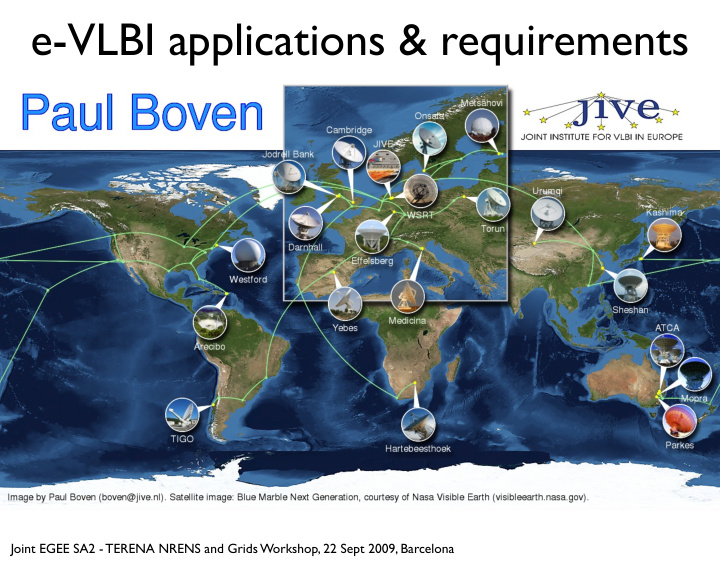



e-VLBI applications & requirements Joint EGEE SA2 - TERENA NRENS and Grids Workshop, 22 Sept 2009, Barcelona
What is JIVE? Operate the EVN correlator and support astronomers doing VLBI. A collaboration of the major radio- astronomical research facilities in Europe, China and South Africa A 3 year program to create a distributed astronomical instrument of inter- continental dimensions using e-VLBI, connecting up to 16 radio telescopes
Radio Astronomy Courtesy of NRAO
Radio vs. Optical astronomy The imaging accuracy (resolution) of a telescope: θ ≈ 1.2 λ /D ( λ = wavelength, D = diameter) Hubble Space Telescope: λ ≈ 600nm (visible light) D = 2.4m θ = 0.06 arcsecond Onsola Space Observatory: λ = 6cm (5GHz) D = 25m θ = 600 arcseconds Wanted: 240km dish
Very Long Baseline Interferometry • Create a huge radio telescope by using telescopes in different locations around the world at the same time
Very Long Baseline Interferometry • Highest angular resolution • High sensitivity • Observations typ. 12 hours • Large data volume Huygens • Active Galactic Nucleae • Supernovae, remnants, pulsars • Spacecraft • And much more
Very Long Baseline Interferometry • Initially (1990) we used large single-reel tapes • Then (2004) came harddisk- packs tekst tekst • And now: e-VLBI
The EXPReS project • EXPReS ran from March 2006 to September 2009 • Fundec by the EC • Established competitive, real-time VLBI • Regularly connecting > 10 telescopes • Global collaboration and reach • Target-of-Opportunity observations • Robust • Producing new science
The EXPReS project Size of bubble set by number of telescopes participating, height by station sustained bit- rate
Lessons from EXPReS • TCP does not perform well on long paths at high speed • UDP requires overprovisioned or dedicated networks • Routed (research) networks, VLANs, Lightpaths • Paths without redundancy have unscheduled outages e-VLBI • Especially the long-haul paths • e-VLBI is robust and efficient
International Year of Astronomy
Observation of J0204+15 (IYA)
Observation of J0204+15 (IYA)
Observation of J0204+15 (IYA)
VLBI and Grids PLot file version 1 created 13-MAY-2009 12:14:40 PLot file version 1 created 13-MAY-2009 12:14:40 PLot file version 1 created 13-MAY-2009 12:14:39 Amplitude andPhase vs Time for N08C1.DIFX.1 Vect aver. CL # 2 Amplitude andPhase vs Time for N08C1.SFXC.1 Vect aver. Amplitude andPhase vs Time for N08C1.MKIV.1 Vect aver. • EVN correlator is hardware based IF 2 CHAN 3 - 30 STK RR IF 2 CHAN 3 - 30 STK RR IF 2 CHAN 3 - 30 STK RR EF - MC ( 1 - 5 ) EF - MC ( 1 - 2 ) EF - MC ( 1 - 5 ) CH 3 CH 3 CH 3 180 180 180 • We have also developed a software 160 160 160 140 140 140 MilliJanskys MilliJanskys MilliJanskys 120 120 120 correlator: Red: SFX Blue: DiFX Green: Mk4 100 100 100 80 80 80 • Higher flexibility, frequency resolution 60 60 60 40 40 40 20 20 20 • Huge computational demand 120 120 120 0 0 0 100 100 100 • Correlation is fairly easy to parallelise 80 80 80 • Low number of operations per byte, Degrees Degrees Degrees 60 60 60 40 40 40 20 20 20 but high input data rate 0 0 0 • Regular ‘batch’-like Grid processing -20 -20 -20 17 27 00 17 27 00 17 27 00 30 30 30 28 00 28 00 28 00 30 30 30 29 00 29 00 29 00 30 30 30 30 00 30 00 30 00 TIME (HOURS) TIME (HOURS) TIME (HOURS) (GridFTP etc.) not a good match • Need clusters with high input connectivity • Researching distributed correlation
VLBI paramater space • Resolution: depends on longest baseline, and observing frequency • Sensitivity: depends on √ Bandwidth, number and size of radio telescopes • Current EVN correlator limitations: 16 stations @ 1024Mb/s each Technological advances in e.g. A/D converters, RF technology, digital signal processing, networking and HPC can now enable much increased sensitivity
The Uniboard project • Collaboration of European & Korean Astronomical Institutes • Reconfigurable FPGA-based platform for astronomical signal processing • Digital back-end, pulsar timing, RFI mitigation, beam-forming, correlation • Standardized on Ethernet 10Gb/s connections • First hardware in December
New telescopes Sardinia 64m Svetloe Irbene 32m Badary Zelenchukskaya Kunming 40m Miyun 50m Yebes 40m
The future of VLBI • All VLBI can be e-VLBI ! • Caching when neccesary (outages, lack of bandwidth) • Real-time correlation is a great diagnostic tool • Much higher bandwidths per telescope • 4 Gb/s soon, 10 Gb/s, how about 64Gb/s ? • More telescopes, global array • New correlators (hardware, software)
Questions?
Recommend
More recommend